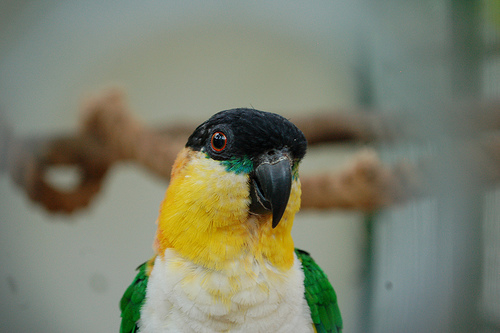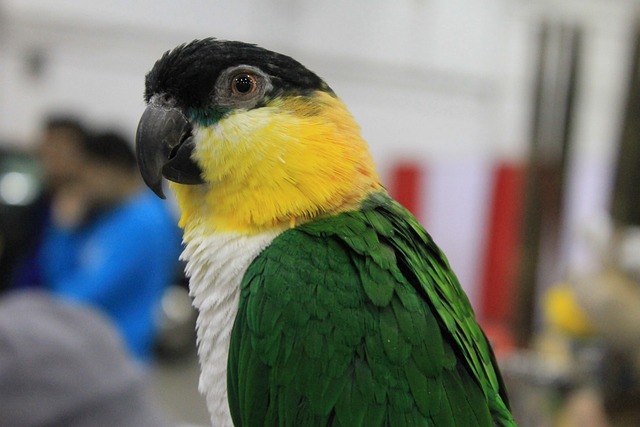Even though the Caique is not readily known as a common companion bird, they are becoming more popular, and why not? Friendly, outgoing, and playful, they are bright and festive which matches their colorful personality. Many consider them the “clown” of the parrot world and for this reason, they’re increasing in popularity. Before you run out to get a Black Headed Caique of your own, there are a few things to consider.

The Low Down on the Black-Headed Caique
The Black Headed Caique, scientific name Pionites melanocephala, is approximately nine inches tall and less than six ounces. They are smaller than the White Bellied Caique. There are two subspecies of this mini parrot.
This colorful parrot is found north of the Amazon River in the countries of Brazil, Columbia, Peru, Venezuela, French Guyana, and Surinam. They are found in the canopy of the forest, along the edges, and often in the woodlands along the savannah. Most often they can be found in small family groups or in flocks of up to thirty birds during the breeding season.
The Black Headed Caique that is most easily found in captivity is the subspecies Pionites melanocephala. It has a white breast and abdomen but a black forehead and crown. They have an orange neck, and their wings, back, and the tail is green.
The subspecies, Pionites melanocephala pallida, is very similar except the orange feathers are yellow on this variety. Younger birds of both species have duller feathers than their adult counterparts. They are expected to live up to 30 years in the wild, possibly longer in captivity.
Many scientists believe that the Black Headed Caique will breed with other species of Caique and can therefore find hybrids in the wild. This may account for the subspecies of this parrot. Some scientists even believe that the Black Headed and White Bellied Caiques will cross-breed in areas where their ranges overlap. You can also check out a not-to-distant relative, the White Bellied Caique.

Training and Caring for your Black-Headed Caique
If you choose to purchase a Caique, you can expect it to be similar to other parrots. Since they are social birds in the wild, you know they’ll need plenty of interaction from you. They need a ready supply of food, plenty of fresh clean water, and a variety of toys to keep them occupied when you’re not with them. Intelligent, they can be trained to learn a variety of tricks.
In the wild, Black Headed Caique normally feeds on fruits, berries, and seeds. In captivity, you can feed them fruits, vegetables, pellets formulated for them, seeds, nuts, and grains. They particularly like flax seeds. Since they are very active, they need a steady supply of food to maintain their energy levels.
The Black Headed Caique obviously lives among other parrots, however, they are wary of their larger cousins and will take flight if one of them comes too close as they see these other parents as an intruder. In fact, if you’re considering purchasing a Black Headed Caique, you probably don’t want to bring it into a home where there is already another species of a parrot or choose not to bring another bird into the home after the Caique gets comfortable with its surroundings.
They have a tendency to bite, as most parrots do, particularly if they experience emotional overload. They may also bite to try to prove their dominance, but they need to understand that biting is not acceptable. To stop their biting, you can train them using positive reinforcement. You may also want to provide them with plenty of destructible toys made of wood.
This will give them ample things to chew on rather than your hand or items you don’t want to be chewed on in your home. They also like noisy toys as well as ropes and ladders that they can do tricks on. Swings are a particular favorite of this small parrot. They need a strong hand to let them know who the boss in your home is. If you don’t stand your ground and establish your dominance when they come into your home, they may quickly become aggressive. Yet, like all animals, dominance cannot be established with aggression and negative reinforcement. Our videos on training caiques will help you understand how to establish this relationship with your caique.
This will have the opposite effect and result in aggressive and destructive animals. Luckily, you can use the same training techniques with a Caique as would work with larger parrots.
This means rewarding positive behavior, ignoring them when they want your attention if they behave badly, and spending time with them daily to ensure they learn what you are trying to teach them.
Even though the Black-Headed Caique is not known for its speaking ability, it can pick up a few phrases that can be understood. They excel, however, at mimicking other sounds heard in the home. You may be surprised to hear them making the same noise as a ringing telephone or someone whistling.
All-in-all, the Black Headed Caique is thought to be a good choice as a pet if you are interested in owning a bird and are willing to invest the time into caring for and training your Caique.
